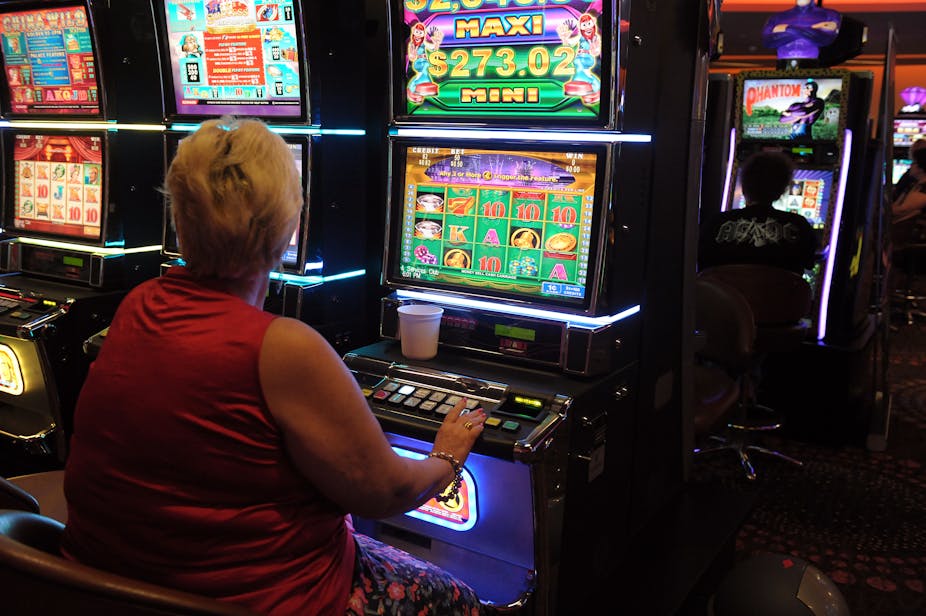Institutions that make big money out of gambling – such as governments, casinos, clubs and pubs – are fond of telling us how much they care about problem gambling.
Clubs Australia (the peak body for the institutions where most of Australia’s poker machines are located) sees itself as part of the solution – although it also sees the problem as “a small minority” of poker machine gamblers.
This concern is usually articulated via the rubric of “responsible gambling”. This, as a colleague and I once commented, is a carefully structured, elastic and goalless term. It transfers responsibility for gambling problems to end users rather than those profiting from the dangerous product.
This has led to education programs, counselling services and notices urging gamblers to “gamble responsibly”. Certainly, there are codes of responsible service of gambling requiring providers to offer relevant information, not to offer inducements and restrict advertising. But in general responsible gambling is about individuals being urged to exercise individual responsibility.
The most recent example of this is the campaign currently underway in Victoria, funded and developed by the Victorian Responsible Gambling Foundation (VRGF). VRGF is an organisation recently established by the Victorian government to undertake the amelioration of gambling harms, fund research, and so on.
The campaign, Fight for the Real You, features four real people sharing real stories via a daily video diary as they tackle their problems with gambling in their “100 Day Challenge”, where:
Our heroes’ stories will be shared via internet films; TV, cinema and online commercials; radio advertisements; and posters in gaming venues.
The campaign will also feature online tools to help people control or stop gambling, and links to counselling services and forums (although, as the Productivity Commission pointed out in section 7 of its 2010 report, only about 10%-15% of problem gamblers use counselling services).
I sincerely hope this campaign helps people overcome the harm being done to them and their families by gambling (especially those featured in the campaign). However, its adoption of “reality” TV concepts that transform affected individuals into a spectacle is alarming, and its likely effectiveness is highly debatable. It may also be at odds with the campaign’s goal to reduce the stigma thought to hinder take up of counselling.
But above all this represents another high profile campaign that unequivocally loads the responsibility of “responsible gambling” squarely on to the shoulders of those carrying the costs of the industry.
If well-resourced TV campaigns won’t stop problem gambling, what will?
The answer to that question can be derived from the history of the public health movement, which had its origins in the mapping of patterns of disease – for example, the way cases of typhoid clustered around a water well, suggesting that the well was likely to be the source of the outbreak.
The way to deal with such a situation is, of course, to fix the well. Better to render the water supply safe for people to use (an “upstream” response), rather than just hand out antibiotics after people are infected and hope they help (a “downstream” response).
This is often referred to as building a fence at the top of the cliff, rather than basing an ambulance at the bottom.
However, cleaning up the source of disease or harm can be unpopular with those who must foot the bill – whether they are local authorities required to clean up a water supply, cigarette manufacturers facing restrictions in the promotion of their product, or pokie businesses anxious about a loss of revenue.
Despite such obstacles, public health learnt long ago that it is far more efficient and effective, and more humane, to fix the source of a problem than to deal with its consequences. Dealing with avoidable harms after they’ve been inflicted means that costs and suffering are much greater than they need be.
The main cause of gambling problems in Australia is poker machines. This is because they are ubiquitous, high impact (they devour a lot of money very quickly) and provide a continuous form of gambling. They are also carefully engineered to be as attractive as possible to users. In effect, they provide “addiction by design”, as Natasha Schüll of the Massachusetts Institute of Technology entitled her recent book on the subject.
The public health response to the poker machine industry is not to ban it. In fact, it has echoed the Productivity Commission. Both want reasonable restrictions on the amount of harm these devices can inflict on their users.
The Productivity Commission recommended two big ideas in this respect: pre-commitment (allowing people to pre-set a solid limit on how much they spend while gambling) and lower maximum bets – $1 per spin rather than the current $10 in NSW and proposed for introduction in Queensland.
In the face of the opposition of the NSW gambling industry, articulated via the threat of a marginal seats campaign, the federal government reneged on its deal with independent MP Andrew Wilkie to introduce pre-commitment. The industry said there was little evidence to support mandatory pre-commitment. In its place, the federal government legislated a policy (voluntary pre-commitment) that does have a solid evidence base: everyone knows it will be almost completely ineffective.
It’s business as usual for pokie harm reduction: responsible gambling.
At its core, “responsible gambling” is a downstream response. It deflect responsibility to affected individuals and, for the most part, only after they’ve fallen off a cliff.
We know what needs to be done to minimise gambling harm. It’s time we stopped reminding those damaged by this irresponsible industry that it’s all their fault. It’s time to start building that fence at the top of the cliff.
We might then be able to proudly claim that we do have a responsible gambling culture. We certainly can’t make that claim now.

